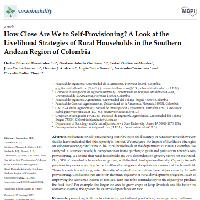Resumen
- Analyze the impact of livelihood strategies on self-sufficiency conditions in 162 rural households in the department of Huila, Colombia. Discuss: A. food source; B. composition of home gardens; C. push and pull factors towards self-provisioning. It turns out that rural households are 79% dependent on grocery stores for their food. Only 51% of households have a family garden, with a limited diversity of plant species. Self-sufficiency capacity varies according to livelihood strategies and household capital endowment. Those households with a greater diversity of agricultural activities have a greater capacity for self-sufficiency. Conditions that are often the main objective of rural development programs, such as improving the economic income of families, are contradictory to the ability to produce the food itself. For example, the greater the area to cultivate or raise livestock and the better the economic income, the greater the external dependence on food.
